AI teases out new antibiotics

Halicin (top row) vs Ciprofloxacin (bottom row). Courtesy of the Collins Lab at MIT.
A team of researchers at the Massachusetts Institute of Technology discovered a powerful new antibiotic compound using a machine learning algorithm. The computer model, which can screen over one hundred million chemicals in a few days, is designed to spot potential antibiotics. It was trained using a catalog of approximately 2,500 molecules with known effects, including approximately 1,700 FDA-approved drugs, before being tested on a library of approximately 6,000 compounds. This is how the model found a molecule, called halicin (SU-3327), with high antibiotic potential. Originally, halicin had been studied for the treatment of diabetes, but was abandoned due to disappointing results. In laboratory tests following the model’s prediction, halicin destroyed many of the most challenging pathogenic bacteria in the world, including some strains that have become resistant to known antibiotics, including Clostridium difficile and Mycobacterium tuberculosis. The molecule also healed mice infected with Acinetobacter baumannii, a bacteria that affected many American soldiers who served in Iraq and Afghanistan. Interestingly, the researchers found that Escherichia coli did not develop halicin resistance during a 30-day treatment period. Researchers have also identified several other promising molecules awaiting testing.
⇨ Ars Technica, John Timmer, “A neural network picks promising antibiotics out of a library of chemicals.”
⇨ MIT News, Anne Trafton, “Artificial intelligence yields new antibiotic.”
